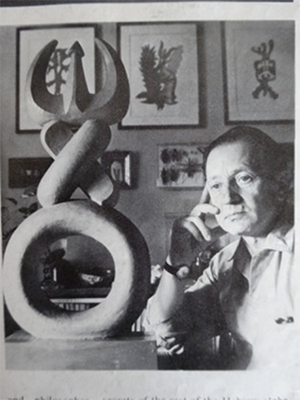The artist József Jakovits (1904-94) is little known even in his native Hungary, except in intellectual and artistic circles, where he is hailed as Hungary’s foremost Surrealist sculptor. In the Hungarian National Gallery he is labeled “Post-Surrealist.†Jakovits viewed himself as a Primitivist, declaring his main sources to be “cave painting, the tribal art of primitive peoples, and the archaic periods of the great religious culturesâ€â€”including Judaic lettering and mysticism. Jakovits is virtually unknown in the United States, despite having lived as a practicing artist in New York City between 1965 and 1987.
Jakovits left Hungary after the country’s powerful cultural czar, György Aczél, told him bluntly that his art could never be publicly accepted in Hungary but that he would make it possible for Jakovits to emigrate.[1] Jakovits returned to Hungary also at Aczél’s urging, after they encountered each other again at a Hungarian reception in New York City, and Aczél enticed him with the promise of an artist’s apartment with studio in Budapest. This is fate that reads like fiction.
Several factors limited Jakovits’s reception during his decades in America, which he had hoped would deliver him recognition. He struggled with English. He shunned social interaction. He quoted Richard Huelsenbeck’s The Dada Drummer: “The artist must by necessity stand outside the social group.†Tidy and efficient, he lived ascetically, in poverty, in a 430-square-foot apartment in a public-housing complex on Water Street. To meet his modest needs of $175 per month—including his art supplies from Pearl Paint—he performed work provided by welfare three days every second week. He said a broad-hipped Jewish woman who worked for the city secured his survival package, which included being registered as a mentally challenged person eligible for aid. This surrogate status also inhibited him from seeking exhibitions and publicity. Despite his monasticism he had television—he watched, from the outside looking in. While America experienced its volatile 1960s, as 1968 came and went, Jakovits was absorbed in painting, having switched his main medium from sculpture. The chance encounter with the Hebrew primer in 1966 was a revelation to Jakovits. He turned from Surrealism to mysticism. He dedicated himself to absorbing and celebrating the esoteric knowledge of Kabala. For more than two decades, he rendered Hebrew letters and kabalistic motifs, employing the flat colors, hard edges, and stenciled designs of Pop Art but in service of the sacred rather than the popular. His meditational motifs did not strike a chord. His work was scarcely acknowledged.

